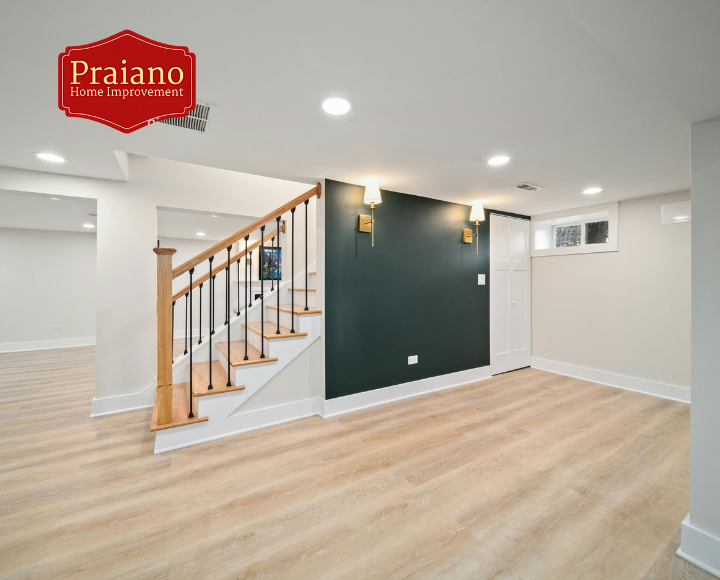Why Long Island Basements Require Special Consideration
Long Island basements face unique challenges that mainland properties don’t encounter. High water tables, coastal humidity, and hurricane flood risks mean that not every basement finishing idea works here. However, when done correctly with proper waterproofing and moisture control, a finished basement can add 10-20% to your home’s value and provide 400-800 square feet of valuable living space. Nassau and Suffolk County homeowners who understand these regional factors make smarter renovation decisions that last.
Essential Waterproofing Before Any Finishing Work
Critical moisture control steps for Long Island basements:
- Interior and exterior drainage systems to manage groundwater
- Vapor barriers on all walls and floors before framing
- Dehumidification systems rated for coastal humidity levels
- Sump pump installation with battery backup (essential for storm season)
- Proper grading away from the foundation
Never finish a Long Island basement without addressing water issues first. Even minor seepage will destroy your investment within months and create dangerous mold conditions.
The water table across Long Island sits higher than in most regions. South Shore communities near Jones Beach and Fire Island face especially challenging conditions that require professional assessment before any finishing work begins.
High-Value Basement Layouts for Long Island Homes
Space configurations that maximize ROI:
Home office or remote work spaces consistently rank as the most valuable basement additions for Long Island professionals. With many residents commuting to Manhattan or working remotely, a dedicated 150-200 square foot office with proper egress adds immediate functional value.
Multi-purpose recreation rooms serve growing families well. Combining entertainment areas with storage solutions addresses Long Island’s space constraints while avoiding the over-specialization that limits future buyer appeal.
In-law suites or rental units offer strong returns in Nassau and Suffolk Counties’ high-cost housing market. However, these require separate entrances, full bathroom facilities, and compliance with local rental regulations. Permit requirements vary significantly between Hempstead, Oyster Bay, and Babylon townships.
Moisture-Resistant Materials for Coastal Basements
Building materials that withstand Long Island conditions:
- Metal studs instead of wood framing (won’t rot or warp from humidity)
- Mold-resistant drywall or cement board throughout
- Luxury vinyl plank flooring over concrete with a moisture barrier
- Closed-cell spray foam insulation (prevents moisture penetration)
- Fiberglass or PVC trim instead of wood baseboards
Carpet should be avoided in Long Island basements entirely unless you install comprehensive dehumidification. Even then, it remains risky. The coastal humidity and potential for water intrusion during nor’easters make carpet a poor long-term choice.
Paint selection requires mold-inhibiting properties. Products like Zinsser Perma-White or Kilz Basement & Masonry are formulated specifically for below-grade conditions and perform well in Long Island’s climate.
Smart Basement Features That Appeal to Local Buyers
Upgrades that resonate with Long Island homeowners:
Adequate ceiling height determines your options. Long Island homes typically have 7-8-foot basement ceilings. If you have less than 7 feet, lowering the floor (underpinning) costs, but may be necessary for livable space.
Natural light transformation dramatically improves basement appeal. Egress windows meet code requirements for bedrooms and make spaces feel less dungeon-like.
Climate control independent from the main HVAC provides year-round comfort. Mini-split systems work exceptionally well in Long Island basements, offering both heating and cooling without extensive ductwork modifications.
Built-in storage solutions address a major Long Island homeowner pain point. Custom shelving, closets, and utility organization can add to project costs but significantly increase functionality.
Red Flags in Basement Finishing Projects
Warning signs that indicate problems:
- Contractors who dismiss water testing or moisture assessments
- Finishing work scheduled before addressing visible efflorescence (white mineral deposits)
- Skipping permits to “save money and time”
- Using standard drywall instead of moisture-resistant products
- Blocking foundation vents or covering necessary access points
- No plan for emergency water removal during hurricanes
Long Island’s building departments strictly enforce egress requirements for basement bedrooms. Any bedroom must have a window meeting specific size requirements and proper emergency escape access. Unpermitted bedroom conversions create serious legal and safety issues.
Never hire contractors who suggest “sealing” foundation cracks with simple caulk or hydraulic cement as a waterproofing solution. These are temporary patches, not permanent fixes for Long Island’s groundwater challenges.
When Professional Contractors Are Non-Negotiable
Projects requiring licensed Long Island specialists:
Any work involving electrical, plumbing, or structural modifications requires licensed professionals familiar with local codes. Long Island building departments conduct thorough inspections, and unpermitted work gets discovered during home sales.
Contact experienced contractors like Praiano Home Improvement when you need comprehensive waterproofing assessments, complex layout planning, or projects requiring coordination across multiple trades.
Emergencies demanding immediate professional help: active water seepage, sewage backup, foundation cracks wider than 1/4 inch, or sagging floor joists above the basement.
Bottom Line: Making Smart Basement Decisions
Successful Long Island basement refinishing always starts with an honest assessment of moisture conditions and proper waterproofing. Shortcuts in these areas guarantee expensive failures regardless of how beautiful the initial finish looks.
Your decision framework:
- Conduct professional moisture testing before any planning
- Budget 20-30% of total costs for waterproofing and moisture control
- Prioritize flexible layouts over highly specialized spaces
- Never skip permits regardless of contractor suggestions
The best basement investments serve your family’s current needs while maintaining broad appeal for future buyers. Avoid over-personalizing with features that only work for specific hobbies or lifestyle choices.
Next Steps for Your Long Island Basement Project
Begin with a professional moisture and structural assessment from a Long Island specialist who understands coastal foundation challenges.
Gather 3-4 detailed proposals from licensed contractors with Long Island basement experience. Verify their waterproofing expertise specifically—general contractors without basement specialization often underestimate moisture challenges.
Review your township’s permit requirements before finalizing plans. Requirements differ significantly between Nassau and Suffolk County municipalities, and non-compliance creates serious resale complications.
Ready to transform your underutilized basement into a valuable living space?
Contact Praiano Home Improvement for a comprehensive consultation that addresses Long Island’s unique basement challenges and creates a finishing plan built to last.
